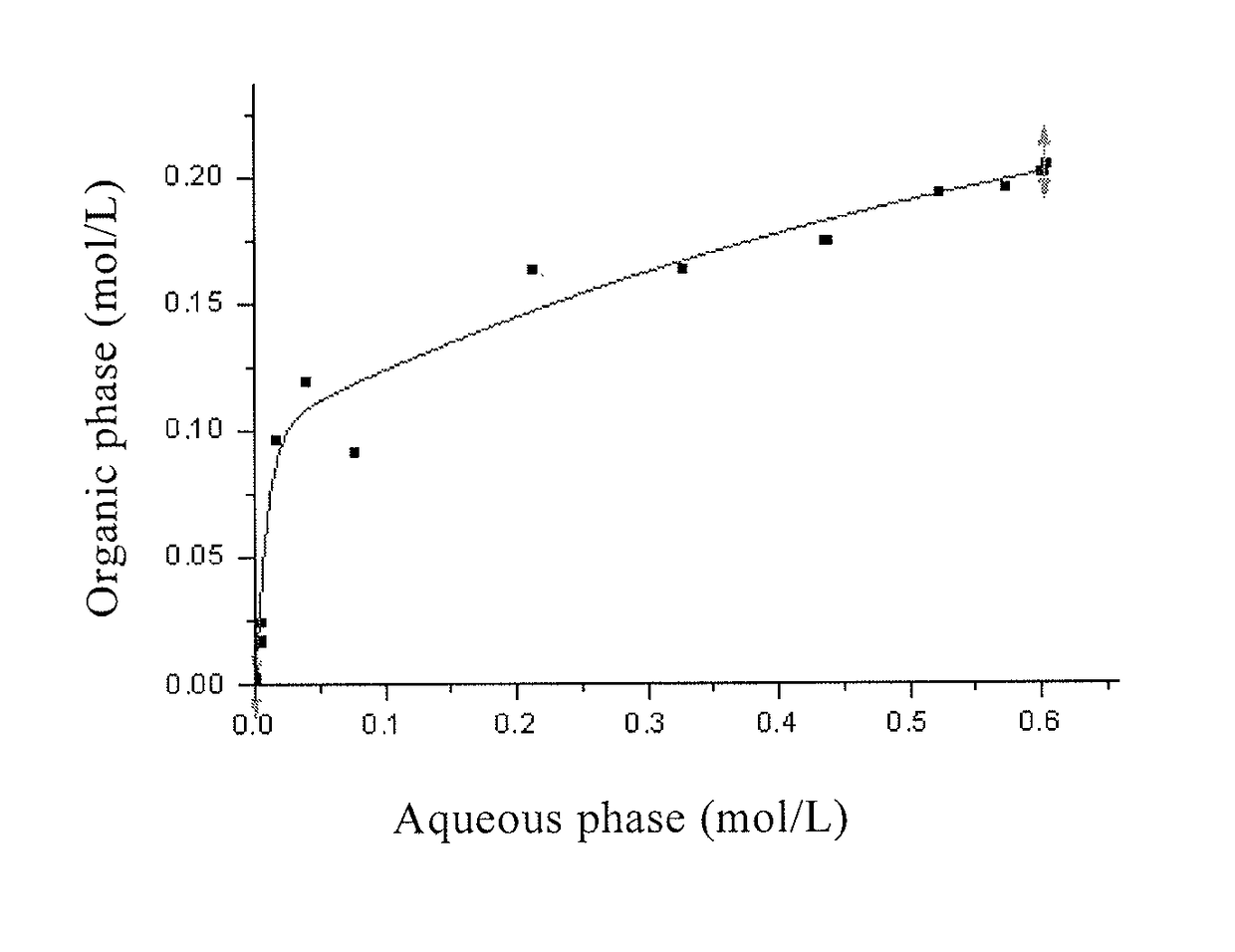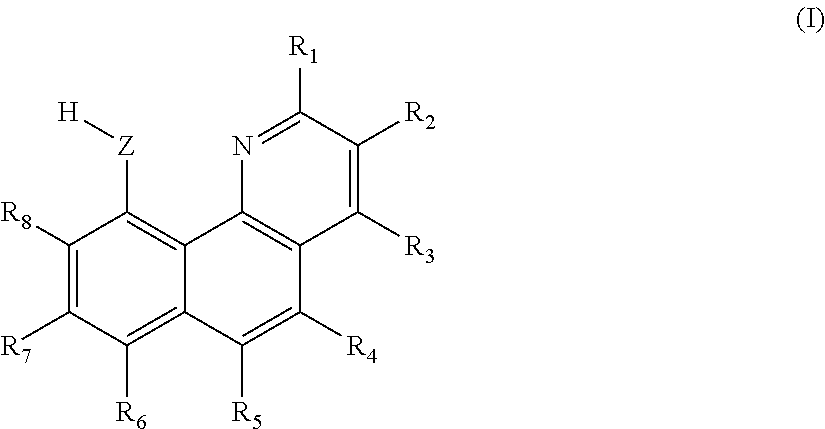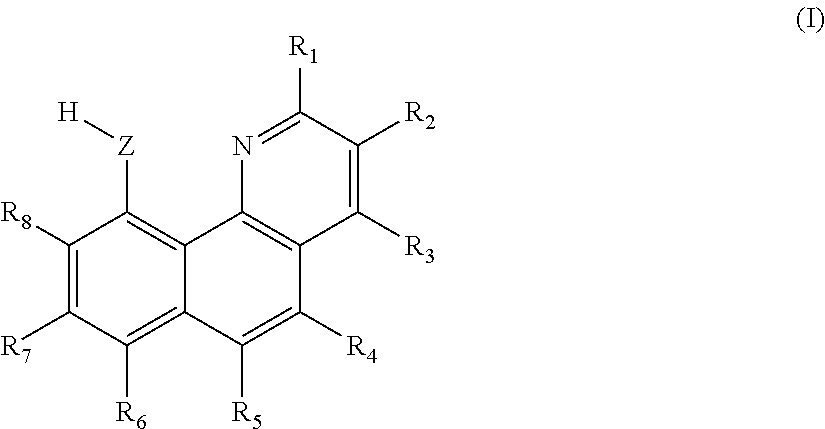Extracting agent for separating lithium isotopes and use thereof
a lithium isotope and extractant technology, applied in the field of chemical engineering, can solve the problems of difficult system synthesis, difficult reuse of extractant, high cost of hydrophilic ionic liquid, etc., and achieve the effects of convenient 7li enrichment, safe and environment friendly, and suitable for multiple stage enrichment and separation
- Summary
- Abstract
- Description
- Claims
- Application Information
AI Technical Summary
Benefits of technology
Problems solved by technology
Method used
Image
Examples
example 1
Single-Stage Extraction Separation Experiment
[0160]Extraction:
[0161]Extraction organic phase: extractant: 0.5 mol / L 7-methoxy-10-hydroxy benzoquinoline; synergic extractant: 0.3 mol / L N263; diluent: chloroform.
[0162]Aqueous phase: 0.2 mol / L LiCl; 6 mol / L NaOH
[0163]Phase ratio: 1:1 (the volume ratio between the organic phase and the aqueous phase) The extraction organic phase and aqueous phase were added into a separating funnel and vibrated for 5 minutes, and then allowed to stand for 5 minutes to stratify. Both phases were collected as the extracted organic phase and the extracted aqueous phase, respectively. Alternatively, a high performance centrifugal extractor was used, and it was continuously charged and discharged at a 1:1 flowing ratio. The two phases were obtained at the exit as the extracted organic phase and the extracted aqueous phase.
[0164]It was determined that the 7Li / 6Li in the extracted organic phase was 14.436, and the 7Li / 6Li in the extracted aqueous phase was 14....
example 2
Single-Stage Extraction Separation Experiment
[0168]Extraction:
[0169]The method of extraction was the same with example 1, but the following conditions were employed:
[0170]Extraction organic phase: extractant: 0.3 mol / L 10-hydroxy benzoquinoline; synergic extractant: 0.6 mol / L trioctylphosphine oxide (TOPO); diluent: dichlorobenzene.
[0171]Aqueous phase: 0.2 mol / L LiCl; 4 mol / L NaOH
[0172]Phase ratio: 2:1
[0173]The extraction distribution ratio was measured to be D=1.6, i.e. the one-time extraction rate was 62% and the single-stage separation coefficient α=1.022.
[0174]Reverse Extraction:
[0175]The reverse extraction method was the same with Example 1, but the reverse extractant employed was 1 mol / L Na2SO4;
[0176]The three-time reverse extraction rate was measured to be 99%.
example 3
Single-Stage Extraction Separation Experiment
[0177]Extraction:
[0178]The method of extraction was the same with example 1, but the following conditions were employed:
[0179]Extraction organic phase: extractant: 0.4 mol / L 10-hydroxy benzoquinoline; synergic extractant: 0.3 mol / L quaternary ammonium salt N263; diluent: trichlorobenzene.
[0180]Aqueous phase: 0.2 mol / L LiCl; 4.8 mol / L NaOH
[0181]Phase ratio: 1:1
[0182]The extraction distribution ratio was measured to be D=1.7, i.e. the one-time extraction rate was 63% and the single-stage separation coefficient α=1.022.
[0183]Reverse Extraction:
[0184]The reverse extraction method was the same with Example 1, but the reverse extractant employed was 1 mol / L NH4Cl;
[0185]The three-time reverse extraction rate was 99%.
PUM
| Property | Measurement | Unit |
|---|---|---|
| thermal neutron absorption cross section | aaaaa | aaaaa |
| pH | aaaaa | aaaaa |
| hydrophilic | aaaaa | aaaaa |
Abstract
Description
Claims
Application Information
 Login to View More
Login to View More - R&D
- Intellectual Property
- Life Sciences
- Materials
- Tech Scout
- Unparalleled Data Quality
- Higher Quality Content
- 60% Fewer Hallucinations
Browse by: Latest US Patents, China's latest patents, Technical Efficacy Thesaurus, Application Domain, Technology Topic, Popular Technical Reports.
© 2025 PatSnap. All rights reserved.Legal|Privacy policy|Modern Slavery Act Transparency Statement|Sitemap|About US| Contact US: help@patsnap.com



